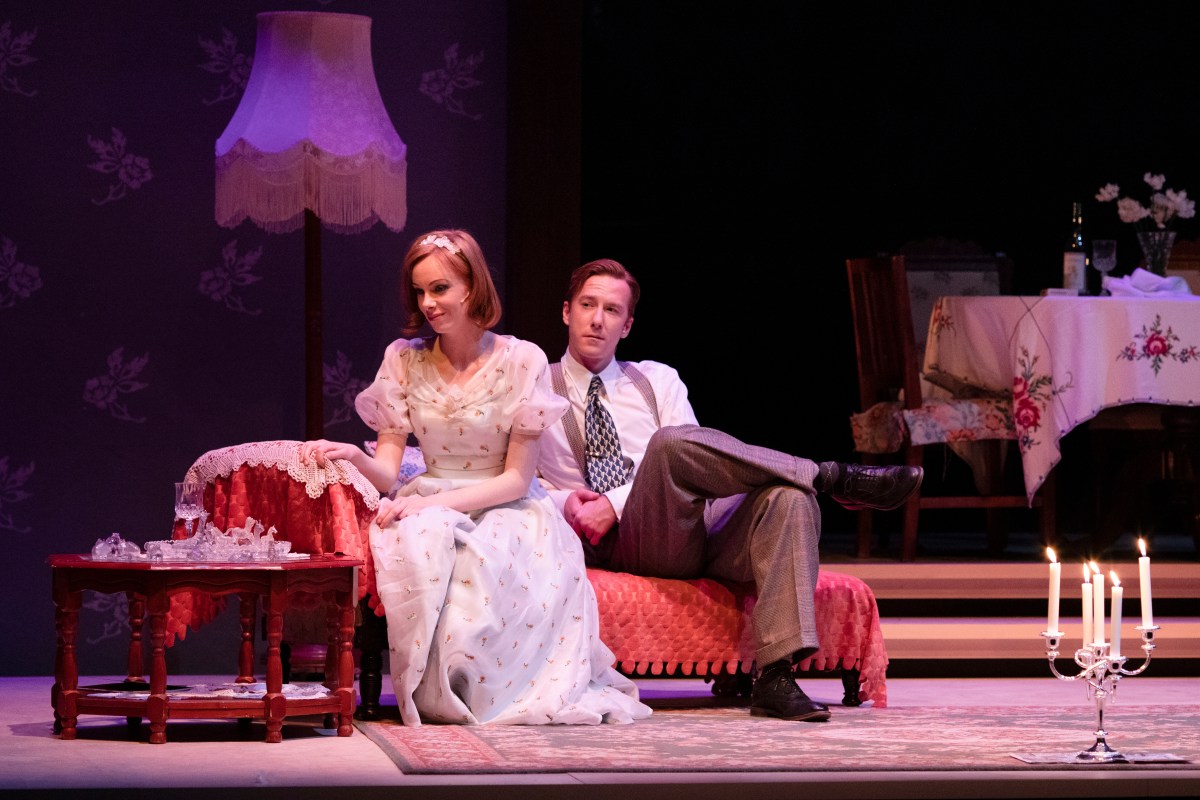The Glass Menagerie by Tennessee Williams is directed by Clare Watson and presented by Black Swan Theatre Company of Western Australia. Beautifully delicate, the play unfolds with soft luminescence, embracing the timelessness of a story about family.
The classic American play is set in 1937 in St Louis, in the Wingfield family apartment. Williams’ writing is lyrical, undulating with the unguarded sadness and wry humour of intense family drama. The portrayal of the complex relationships between the mother, Amanda Wingfield, her son Tom, and daughter Laura, is authentic and relatable. ‘The play is memory,’ explains narrator and character, Tom Wingfield, as he stands on a fire escape speaking directly to theatre patrons.
Audience members respond to the immediacy and relevancy of the story, for this is a ‘play about longing and yearning, memory and nostalgia, escapism and dependency,’ Watson writes in the program notes.
Watson, Black Swan’s former Artistic Director, has gently rendered a sad and relatable retelling of Williams’ enduring play. Her delicate touch is nuanced; characters move with easy geniality, their interactions subtly shaped by her vision for the script. She presents the typically maligned Wingfield matriarch as a strong single mother who prioritises the needs of her children rather than as an overbearing, dominating, or bitter woman. The work is deftly handled, and humorous.
Amanda Wingfield is played with accomplished skill and sensitivity by Mandy McElhinney. Her posture and movement are confident, her Southern American accent full and charming. She is likeable and although may have easily presented as a controlling mother figure, McElhinney delivers a woman who is selfless, funny, and strong, her actions understandable because of her evident love for, and indubitable frustration with, her adult children.
Tom Wingfield is played with passionate enthusiasm by Joel Jackson, who is responsive to audience reactions, other performers on stage, and his own character’s story. He uses humour well, taking pleasure in his role as narrator in the present time, and as the aspiring poet planning for his future, in the past. The repetition of the line, ‘I’m going to the movies’, as the constant reason for escaping the apartment elicits chuckling as viewers recognise both a child’s desperate excuse to leave and a mother’s predictable protests for more information.
Laura Wingfield, as played by Acacia Daken, provokes pity. Performed with fragile transparency she presents as traumatised and insecure until a moment of hope allows the audience to glimpse the beauty and kindness of her character. Her lithe form contrasts with the restlessness of her brother, and intense focus of her mother. Her anxiety peaks with the prospect of the arrival of ‘The Gentleman Caller’, Jim O’Connor, played with verve by Jake Fryer-Hornsby.
The presence of composer and pianist, Tom O’Halloran, seated at a grand piano upstage centre and dimly lit, is an inspired element. His silhouette shifts with the wash of lights and with his body movement as he reaches to play piano strings as well as the keyboard. The musical score enhances the mood of the play, holding and releasing emotion. As the narrator Tom, explains in Scene One, it’s important to note ‘Everything happens to music’.
Read: Theatre review: Strange Case of Dr Jekyll and Mr Hyde
Contemporary elements including projections of text, letters, fractured images, and videos as well as sophisticated lighting design and thoughtful set and costumes are cleverly integrated to serve the vision of memory-making as meaning.
Video designer, Michael Carmody, incorporates fragments of text, images, and videos to extrapolate and enhance action, such as projected blue roses unfurling and furling, or images of fracturing glass. As he points out, Carmody delights in ‘using text and image to punctuate moments, accent values, and frame the world’.
The set and costume design by Fiona Bruce is elegant and simple. The domestic set contrasts with the grandeur of the regal theatre by using sparse, functional décor. The use of scrims is effective in enhancing the sense of illusion, allowing for semi-transparent movement. The sheer screens are at times room partitions and at other times used for silhouetting and the projection of videos and images. Lucy Birkinshaw’s lighting is sensitively designed to highlight, illuminate, obscure, and reveal.
The choice to play Blondie’s Heart of Glass at the close of the play allows for smiles and a little levity as audience members applaud cast and crew before thoughtfully, quietly departing.
The Glass Menagerie is a gauzy simulacrum, a poignant portrayal of the difficulties of family relationships. ‘And so, goodbye,’ the narrator, Tom, sadly concludes at the end. Yet, the Wingfields’ interactions linger, echoing within one’s own memories of personal family interactions. Long after patrons leave the theatre to return to the intimate realities of home and family life, traces of sadness remain as signs of truth.
The Glass Menagerie by Tennessee Williams
Adapted by Black Swan State Theatre Company of WA
His Majesty’s Theatre, Perth
Director: Clare Watson
Composer and Pianist: Tom O’Halloran
Set & Costume Designer: Fiona Bruce
Lighting Designer: Lucy Birkinshaw
Video Designer: Michael Carmody
Voice & Accent Coach: Julia Moody
Stage Manager: Megan Fitzgerald
Assistant Stage Manager: Georgia Smith
Cast: Acacia Daken, Jake Fryer-Hornsby, Joel Jackson, Mandy McElhinney
Tickets: $30.00-$129.00
The Glass Menagerie will be performed until 21 August 2022.





